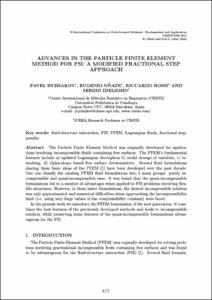Advances in the particle finite element method for FSI: a modified fractional step approach

Visualitza/Obre
Estadístiques de LA Referencia / Recolecta
Inclou dades d'ús des de 2022
Cita com:
hdl:2117/189360
Tipus de documentText en actes de congrés
Data publicació2011
EditorCIMNE
Condicions d'accésAccés obert
Tots els drets reservats. Aquesta obra està protegida pels drets de propietat intel·lectual i
industrial corresponents. Sense perjudici de les exempcions legals existents, queda prohibida la seva
reproducció, distribució, comunicació pública o transformació sense l'autorització del titular dels drets
Abstract
The Particle Finite Element Method was originally developed for applications involving incompressible fluids containing free surfaces. The PFEM’s fundamental features include a) updated Lagrangian description b) nodal storage of variables, c) remeshing, d) alpha-shape based free surface determination. Several fluid formulations sharing these basic ideas of the PFEM [1] have been developed over the past decade. One can classify the existing PFEM fluid formulations into 2 main groups: purely incompressible and quasi-incompressible ones. It was found that the quasi-incompressible formulations led to a number of advantages when applied to FSI problems involving flexible structures. However, in these latter formulations, the desired incompressible solution was only approximated and numerical difficulties when approaching the incompressibility limit (i.e. using very large values of the compressibility constant) were faced. In the present work we introduce the PFEM formulation of the new generation: it combines the best features of the previously developed methods and leads to incompressible solution, while preserving some features of the quasi-incompressible formulations advantageous for the FSI.
ISBN978-84-89925-67-0
| Fitxers | Descripció | Mida | Format | Visualitza |
|---|---|---|---|---|
| Particles_2011- ... in the particle finite.pdf | 249,0Kb | Visualitza/Obre |

